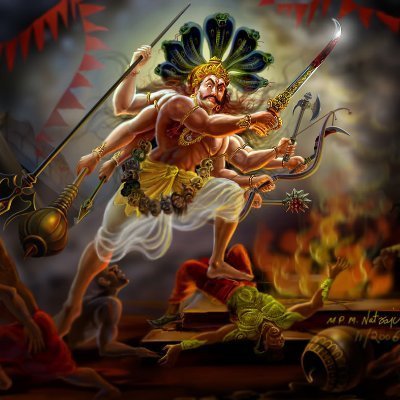
Shambhu rose in a violent anger like that of a raging fire. His eyes, nose, ears, and mouth were letting off innumerable sparks, and with this seething fury, he rushed to the site of the Mahayagna. He stopped himself just outside the sacrificial space and watched everything unfold with his fiery eyes.
Mahadeva became terribly enraged, and from the fierce depths of his anger emerged Virabhadrar — who was no different from Mahadeva’s own blazing wrath. This is why he is called Rudra-kopa-sambhava — born of Rudra’s fury.
Without delay, Mahadeva sent Virabhadrar into the altar where Daksha’s grand Yagna was underway.
Virabhadrar then created his own Bhuta Ganas, terrifying beings of great power, and began destroying the sacrificial altar of Daksha. Vishnu, seeing this upheaval, tried to stop Virabhadrar.
But witnessing this, Shambhu’s anger intensified further. He himself stepped into the sacrificial grounds and began destroying everything with his own hands.
At that moment, Bhaga, one of the Dvādaśa Ādityas, approached Shambhu in an attempt to stop him. But Mahadeva, with just his fingers, pulled Bhaga’s eyeballs out.
Next came Surya Bhagavan, approaching after seeing Bhaga’s fate. Swamy grabbed both of his hands and flung him far away — effortlessly — before he rushed straight toward the main sacrificial altar.
Then appeared Martanda, another form of the Sun, who mockingly laughed and said, “Come on, I shall fight you!”
Seeing this disrespect from Martanda towards Shambhu, Virabhadrar stepped in and slapped him so hard that all of Martanda’s teeth fell out.
Witnessing the sheer destructive force of Mahadeva and Virabhadrar, all the gods and sages fled in fear.
Shambhu then turned toward the sacrificial Yajña, which had now assumed a living form and was standing within the altar. But upon seeing the raging Shambhu, the sacrifice itself transformed into a deer and fled.
It ran all the way to Brahmaloka, with Mahadeva following in pursuit. But fearing Pāśupati, the living sacrifice used its mayājāla (web of illusion) and descended from Brahmaloka — entering into the body of Sati.
Shiva, having chased the sacrifice all the way, now found himself beside the lifeless body of Sati. In that instant, he forgot the chase and simply sat down next to her, mourning her deeply.
All the beautiful moments they had shared came flooding back into his memory. He began crying aloud — his heart pierced with sorrow like a thorn piercing a rose petal.
Kamadeva, seeing Shiva in such a state, pierced the heart of Shambhu with multiple arrows — not to inflame desire, but to keep him grief-stricken enough to prevent the world from being destroyed in rage.
It worked. Mahadeva’s fury subsided. He began speaking gently to the dead Sati, as if she were only sleeping. He tried to wake her.
Tears rolled down from his cheeks — and these divine tears struck fear in the hearts of Brahmādi Devatās, for they knew even a single drop could burn the whole Earth to ashes.
So they prayed to Shani Bhagavan, the lord who had once stopped rains for a hundred years, to now halt Shiva’s tears.
Shani accepted their plea. With his power, he managed to stop the tears to some extent. But when he could no longer restrain them, he cast the tears onto a mountain named Jaladhāraka.
The mountain, unable to withstand the fire of Shiva’s sorrow, cracked apart. The tears then spilled into the sea.
The sea itself split, and from it a new river emerged — the Vaitarani, which to this day flows through the realm of Yama Pattana, the city of the god of death.
Then, Shiva lifted the lifeless body of Sati onto his shoulder and began wandering across the lands — like a madman.
Because the dead body was in constant touch with Shiva, it did not decay. And it was only when the body began to rot that it would fall from his shoulder — allowing Shiva to regain his senses.
Brahma, Vishnu, and Shiva began deliberating, searching for a way forward. At last, they found a solution — and with the grace of Mahamaya, all three entered into the dead body of Sati.
The Subtle Play of Mahamaya
This entire episode isn’t just about rage, loss, or cosmic disruption. It is Mahamaya’s supreme orchestration, revealing how even Shiva — the untouched, the supreme — can be drawn into grief, madness, and destruction, when She wills it so.
Sati’s decision to abandon her body wasn’t rebellion — it was Mahamaya’s exit cue.
The Yajna’s destruction wasn’t vengeance — it was the unraveling of an ego-fueled sacrificial delusion, brought down by Her touch as a lesson for the future men.
Virabhadra’s emergence from Shiva’s anger shows how even fury becomes a tool in Her hands where usually anger blinds the wielder.
Shiva forgetting his purpose after Sati’s death shows how even the Knower of Time gets bound when Mahamaya enters the stage.
She enters through delusion (mohamaya), sets fire to karmic structures, and exits with the promise of rebirth — not just for Sati, but for dharma itself.
Thus, Kamakhya is not a passive witness — She is the scriptwriter, the actress, and the curtain-dropper of this divine tragedy.
Kamakhya Tattva Bodha continues..
You shall click here to get our ebook of Kamakhya Tattva Bodha.


Really thankful Sir for sharing this🙏I have never come across such a beautiful way in which you have written the sequence of events.. one can feel it from within.. really incredible 🙏
I have never come across such a beautiful way in which you have written the sequence of events.. one can feel it from within.. really incredible 🙏
Namaskaram Guruji, Gratitude for sharing the events/story in such a wonderful way.I do not see any one doing it in such a beautiful way,other than you.🙏🙏🙏